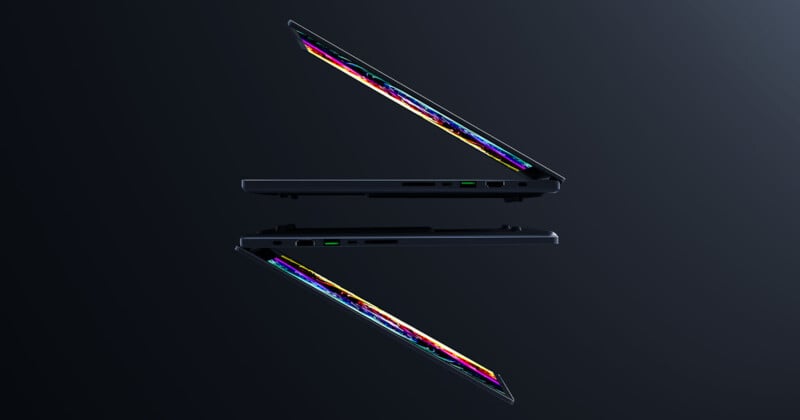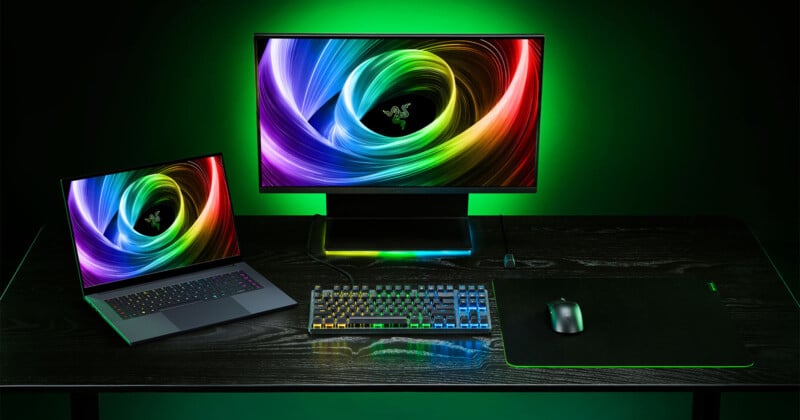 Credit: Razer
Credit: RazerRazer rolled out a slew of new products at CES 2025, led by another iteration of its Blade 16 laptop. Gamers are still the primary targets, but the company has also tried to cater to creatives with what it sees as robust performance.
The 2025 Blade 16 is the only laptop Razer is showing or talking about at the show in Las Vegas. It’s also not revealing much about how well it performs because company reps have barely had the chance to put it through its paces themselves. Still, the specs indicate changes afoot, and reps suggest they will address some of the challenges from previous models.
![]()
PetaPixel certainly ran into some with the 2024 model, particularly with Adobe’s photography apps, and it’s too premature to report whether the 2025 version will fare better. I got to see the new Blade 16 up close on the eve of CES, and here are some first impressions.
Shedding Weight, Slimming Down
Off the bat, it’s evident Razer isn’t exaggerating when it says its new laptop is 32% thinner (15 millimeters / 0.6 inches) and 15% lighter (2.1 kilograms / 4.6 pounds). Holding it in one hand with the 2024 model in the other makes that clear. That’s great for an otherwise hefty laptop with an aluminum body and one with very similar components.
![]()
The 16-inch OLED display is the same panel as the 2024 model, so it has a QHD+ (2,560 x 1,600) resolution with 100% DCI-P3 color gamut, VESA Clear 11000, and DisplayHDR True Black 500 certifications. The 0.2-millisecond response time and 120Hz refresh rate at full resolution (240Hz in 1080p HD) also remain unchanged. The Chroma RGB keyboard has the same layout; only the key travel dives deeper to 1.5 millimeters. It’s a noticeable difference that many gamers and creatives will like because it makes the typing experience feel more natural and substantial.
The ports also carry over the same way, with one exception being there being no Thunderbolt ports because there’s no Intel CPU in sight. To recap, that’s one USB-C port, three USB-A ports, HDMI 2.1, SD card slot, plus Wi-Fi 7 and Bluetooth 5.3 for the latest in wireless connections. To make up for the lack of Thunderbolt ports, you’ll have to use a dock or hub with those ports if you want the most flexibility in setting up multiple monitors.
Exit Intel, Enter AMD
It is a little surprising Razer is exclusively going with an AMD Ryzen AI 9 HX 370 processor for the new Blade 16. From what reps have told me, there will be no Intel variant. It is also a Copilot+ PC with a neural processing unit (NPU) to handle AI-driven tasks. The keyboard even has a dedicated key for it, as all the others do. It’s the only real difference I’ve seen on the keyboard visually.
Razer concedes the AMD chip won’t be as powerful as its Intel counterpart, but will generate less heat and perform more efficiently. With Nvidia RTX 50-series graphics chips on board, it will be interesting to see how this combination will work. Configurations will range between RTX 5060 and 5090 in 2025. Nvidia says the 5070 delivers the same performance as a 4090 GPU. We have no way to verify these figures, but they set some expectations.
Razer says another improvement will come with the rejigged thermal resistance and cooling system that will dissipate heat and keep the Blade 16 cooler than before. All this retooling inside also comes with compromises. The new laptop will have LPDDR5X RAM, which means it’s soldered to the motherboard rather than inserted and swappable for future upgrades.
How all of this will affect battery life is hard to predict. The 2024 Blade 16 was a sieve for battery life when pushed, and the 2025 model uses the same battery. The only difference is it’s a 90Wh battery compared to the 92Wh one in the 2024 version. If battery life gets better, it will have to be because of all the aforementioned elements and efficiencies Razer’s baked in. The previous Blade 16 gets hot, and its fans roar, so we’ll have to see if that changes this year.
 Credit: Razer
Credit: RazerCooling Pad to the Rescue?
One of the more interesting demos revolved around the Laptop Cooling Pad Razer previously launched in 2024. Razer calls it “HyperBoost” and it employs “smart cooling” that interfaces with laptops using its Synapse software to change fan speeds and reduce their temperatures beyond what the vapor chamber cooling system can do on its own. It offers manual input but can also monitor on its own independently to adjust as temperatures rise or fall.
![]()
Razer had one Blade 16 (2024) on a Cooling Pad with HyperBoost active, while another didn’t. Both were running the same processes but there was a significant difference in temperature to the touch between them. From a gaming standpoint, the company says gamers can hit higher framerates in games that otherwise struggle to render properly. It’s unclear what a commensurate benefit would be for creative apps, like video editors, but a cooler system helps a laptop run smoother.
The Laptop Cooling Pad costs $150, but HyperBoost is free and not exclusive to Razer’s devices. You could run Synapse on other Windows PCs to get a similar benefit. Without testing it, it’s hard to tell, but there may be a way to mitigate some of the heat and noise from a loud laptop.
A Sturdy Monitor Stand
If your desk is big enough for the Laptop Cooling Pad and a monitor, Razer has a stand to sell you. The Monitor Stand Chroma is big, made of anodized aluminum, and able to handle up to nearly 20 kilograms (44 pounds). It measures 50 centimeters (19.7 inches) long and 21 centimeters (8.3 inches) wide, with rubberized pads underneath to ensure it never slips. There’s enough clearance beneath to fit just about any laptop, or whatever else you prefer to slide through it.
Chroma RGB lighting adds color to the mix, including a dedicated button on the stand to cycle through lighting presets or to launch an app or game. It’s a customizable button that you can set up for a single task.
 Credit: Razer
Credit: RazerIt also has its own set of ports as a hub. There are two USB-A 3.2 ports, one USB-C and one HDMI 2.0, all of which are active once you plug in the included USB-C cable to a laptop. It lets you connect another monitor or peripherals like a keyboard and mouse, making it easier to place the laptop under the stand.
Pricing and Availability
The Monitor Stand Chroma won’t come cheap at $200 when pre-orders start in January 2025, but making it a hub also helps justify the price.
As for the Blade 16 (2025), Razer won’t be launching that to market until mid-February at the earliest, though it is targeting a Q1 release to the market. Razer has not announced pricing for the new sleeker Blade 16.
Image credits: Images by Ted Kritsonis unless otherwise noted




 English (US) ·
English (US) ·